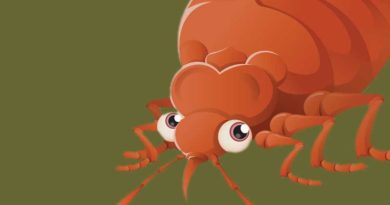The bed bugs are still BITING!
A 2011 survey conducted by the National Pest Management Association and the University of Kentucky has found that bedbug infestations are still increasing nationwide. A total of 99 percent of the respondents, consisting of pest management professionals, said they encountered bedbug infestations in the year prior to the survey. More than eight out of 10 noted that bedbug infestations are on the rise across the country. The survey also found that bedbug infestations have become more common in public places, and the number of professionals that encountered bedbugs in hotels/motels increased from 67 percent in a previous survey to 80 percent. Prior to 2000, only 25 percent of survey respondents encountered a bed bug infestation.
According to the EPA, bedbugs are blood-sucking external parasites similar to head lice, and they are not known to transmit disease. But they are still a pest of significant public health importance. Bedbugs cause a variety of negative physical health, mental health, and economic consequences. When bitten, many people have a mild to a severe allergic reaction to the bites, with effects ranging from no reaction to a small bite mark to severe, whole-body reaction.
These blood-suckers do not discriminate. Bedbugs are infesting homes, apartments, retail stores, offices, places of worship, college dorms, hospitals, daycares, libraries, movie theaters, and laundry facilities. And, of course, resorts and hotels are at risk. There is even a website (www.bedbugregistry.com) that is a public database of user-submitted bedbug reports from the US and Canada. Certainly not a list you’d want to be on. The good news is you can work to prevent a major infestation, and if you already have a problem, there are treatments.
“Bedbugs are found in resorts and other overnight facilities for one reason – your guests are their prey,” said Pat Copps, technical services manager for Orkin Commercial Services.
“They typically live within 15 to 20 feet of their food source – humans. These insects are good hitchhikers and can find their way to a property via luggage or used furnishings. Resorts and hotels are particularly at risk for bedbugs due to the transient nature of their guests, and the ease with which bedbugs can travel in luggage or other guest belongings.”
According to an article written by Michael F. Potter, an entomologist with the University of Kentucky College of Agriculture, adult bedbugs are about 3/16-inch in length and reddish-brown, with oval, flattened bodies. The young bedbugs resemble the adults, but they are smaller and lighter in color. Bedbugs can move quickly over floors, walls, ceilings, and other surfaces. Female bed bugs lay their eggs in secluded areas, depositing one, two, or more eggs per day and hundreds during a lifetime. The eggs are tiny, whitish, and hard to see on most surfaces without magnification.
Related: Why Bed Bugs Biting Again
Bedbug infestations have nothing to do with a lack of cleanliness. “No matter whether it’s a five-star resort or smaller motel chain, no one is immune from bedbug infestations,” Copps told us. “An excellent sanitation program will not safeguard an establishment completely from bed bugs because sanitation is not a factor when it comes to these pests. The fact is, bedbugs can thrive in a spotlessly clean room. However, clutter will provide harborage and may make inspection and treatment difficult.”
Because bedbugs reproduce at alarming rates – two can produce 10 eggs in one day – it is critical to detect and treat infestations early. “The key to bedbug prevention is constant and consistent monitoring. It’s important that housekeeping regularly checks unit ‘hot spots’ for bedbug activity because guests are continuously coming in and out of rooms and the property, and bedbugs can ‘hitchhike’ a ride on their belongings. With constant monitoring, if an infestation occurs, it will be on a much smaller scale and can be dealt with quickly and with minimal impact on your guests’ stay – and your property’s reputation,” Copps continued.
“Bedbugs tend to hide during the daytime, making it difficult to spot them, but they are easily identified by the brown or red stains they leave behind after they feed. Larger bedbug infestations may be detected by a musty, sweet odor like soda syrup, but this may not be readily apparent,” said Copps.
During the inspection, a flashlight can be used to look for some of the most common bedbug “hot spots” in resort units or hotel rooms. HowIgetridof.com says to carefully inspect the following:
- All Mattresses And Boxsprings
- Bed Headboards, Footboards, bed frames
- In Bed Sheets
- Cribs And Strollers (If applicable)
- All Other Furniture, (i.e. Desks, Tables, Nightstands, etc)
- Along All Baseboards
- Carpets
- Walls
- Behind Picture Frames
- Book Shelves
- Under Beds
- Couches, Chairs, Sitting Areas (Under-seat cushions)
- In Closets
- All Electronics (In and under bedside light fixtures)
- All Appliances
Other hiding places could include buckling wallpaper or carpet.
“The best course of action to deal with a bedbug problem is to create and maintain a treatment and prevention plan with your pest management specialist,” said Copps. “He or she will work with you to educate your housekeeping staff on the steps to take when they find an infestation.
Related: Don’t let the bed bugs bite
“If housekeeping suspects a bedbug infestation, immediately take the room and the surrounding rooms out of service and do not remove any items from the room. This will help to isolate the incident and prevent bedbugs from further infesting your establishment. Relocate the guests staying in the infested room and its surrounding rooms to other rooms. Once the rooms are clear of guests, contact your pest management specialist to inspect the rooms, confirm the infestation, and determine the best treatment options for the establishment. If an infestation is detected, you will need to work with your pest management specialist to prepare the room,” Copps continued.
“Two available treatment options include removing and thoroughly cleaning all furniture in the infested room and pre-treating rooms where you relocated your guests to prevent further infestation. Steam cleaners, which operate at high temperatures, can be used to kill any eggs that have been laid in the infested areas of the room. To prevent further infestations, your pest management specialist will treat the area with materials, such as repellent, non-repellent dust, and insect growth regulators,” said Copps.
Another way to inspect for these pests is to hire a company that will bring in a specially trained bedbug-sniffing dog. Colorado Bed Bug K9 is one such company. Walter Penny, along with his “partner” Macaroni, a Labrador/beagle mix rescued from a shelter, tells his clients that they can provide accuracy for detecting bedbugs well beyond that of a human inspector. Prior to starting Colorado Bed Bug K9, Penny worked for a large pest control company.
A company in the New York City area, Stern Environmental Group LLC, uses a non-toxic, environmentally safe carbon dioxide vapor called Cryonite to kill bedbugs by freezing them. The vapor is particularly effective in penetrating under furniture and into cracks and crevices where bedbugs hide. ThermaPure, a Ventura, Calif., company uses a combination of carefully applied and monitored heat, air circulation, and air filtration to penetrate structures – including wall cavities, structural members, and cracks and crevices – with a level of heat that is lethal to bedbugs and their eggs.
More information about bedbugs can be found on the Environmental Protection Agency’s website.
www.epa.gov/bedbugs



